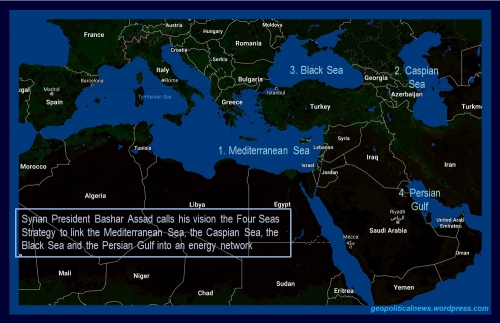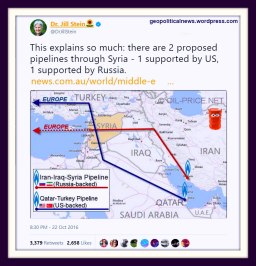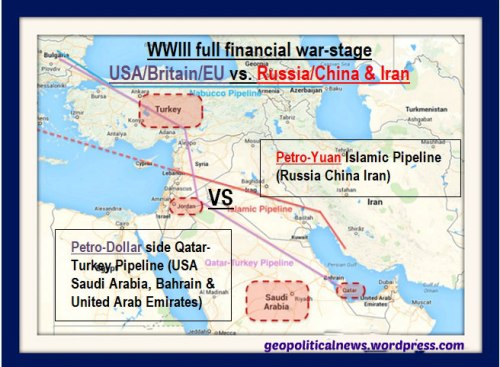“. . . There are a lot of every day human beings being marginalized by our very corrupt political system . . . [with] two political parties who are funded by predatory banks, fossil fuel giants and war profiteers…” —Dr. Jill Stein | US 2016 Presidential Candidate
Looking at all the illegal wars the United States of America, the rogue Empire of Chaos, has in progress, the most complex one is probably the Syrian war. So what could drive the U.S. to undertake such a crusade in this already battered part of the world? Why is the Rogue Empire of Chaos waging yet another war? Let’s follow the money trail and look at a few facts about Syria.
Since the 1980s, Syria has been depleting its resources of own crude oil. After peaking at 650,000 bpd (barrel per day) in 1995, crude oil production has plummeted to about 380,000 bpd in 2007. With declining output and rising consumer demand for petroleum products, Syria’s overall oil balance has turned negative in 2007, thus the need for Syria to orientate itself towards new sources of revenue.

Image 1. Bashar Al-Assad Four Seas Strategy Project | Google Maps
In 2009, recognizing that the heady days of Syrian oil production of the 1980s were long gone and that the sector’s future lay in transit, Syrian President Bashar Al-Assad announced a “Four Seas Strategy” (Image 1.) aimed at transforming the country into a regional hub for oil transportation between the Persian Gulf and the Black, Caspian and Mediterranean seas. Bashar Al-Assad started at taking steps to realize the country’s transit-center potential and bring the four seas strategy closer to reality.
In late 2010, Bashar Al-Assad’s government signed a memorandum of understanding with Iraq for the construction of two oil and one gas pipeline to carry gas and oil from Iraq’s Akkas and Kirkuk fields, respectively, to the Syrian port of Banias on the Mediterranean Sea. In July 2011 Iranian officials announced a $10 billion gas pipeline deal between Syria, Iraq and Iran that would transport gas from Iran’s South Pars gas field, the world’s biggest, through Iraq to Syria.

Image 2. Tweet from Dr. Jill Stein | October 22. 2016 | 8:30 PM
Looking back at the 2016 U.S. Presidential election Geopolitical News recalls Presidential Candidate Dr. Jill Stein as the only candidate who had the honesty to inform her voters about the real reason for the US-Syrian war (Image 2.). It’s about the United States of America and Russia controlling the Persian Gulf’s largest liquid natural gas field in the world. This gas field is shared between Qatar and its North Dome and Iran and its South Pars. Here are a few facts about the North Dome/South Pars gas field from Wikipedia:

Image 3. Qatari North Dome and Iranian South Pars | Wikipedia
The South Pars/North Dome field is a natural-gas condensate field located in the Persian Gulf. It is by far the world’s largest natural gas field. Iran and Qatar share ownership of the field. According to the International Energy Agency (IEA), the field holds an estimated 1,800 trillion cubic feet (51 trillion cubic meters) of in-situ natural gas and some 50 billion barrels (7.9 billion cubic meters) of natural gas condensates. On the list of natural gas fields it has more recoverable reserves than all other fields combined. It has significant geostrategic influence. This gas field covers an area of 9,700 square kilometres (3,700 sq mi), of which 3,700 square kilometres ,400 sq mi) (South Pars) is in Iranian territorial waters and 6,000 square kilometres (2,300 sq mi) (North Dome) is in Qatari territorial waters.
A “minute detail” that bothers the U.S. neocons is the fact that Syrian President Bashar Al Assad has refused to support the Qatari pipeline in favor of the Iranian one sponsored and supported by Russia: one of the main reasons why the US and Europe are involved in a conflict of geopolitical and geo-strategic importance: the Syrian conflict is about who will control the export of Middle Eastern gas: the United States of America or Russia?
Brazilian reporter Pepe Escobar qualifies this war as “Syria’s Pipelineistan being a war of deals, not bullets.” Please notice that the LNG reserves of Qatari-Iranian North Dome South Pars gas fields have more recoverable reserves than all other fields combined.
It’s about the geopolitics of who is going to control the supply of LNG towards Europe and the world: Qatar and its US allies defending the Petrodollar or Iran and its Russian allies defending the Petroyuan? (Image 4.)

Image 4. Persian Gulf: Qatar and Iran | Qatar: North Dome & South Pars: Iran | Google Maps
Pipeline One: Petroyuan Russian side: Persian Gulf South Pars from Iran via Iraq, Syria, Lebanon; a project backed up by Russia (Gazprom), Iran and China.
Pipeline Two: Petrodollar U.S. side: Persian Gulf North Dome from Qatar, via Saudi Arabia, Jordan, Syria; a project supported by the United States of America and its allies: Saudi Arabia, Bahrain and the United Arab Emirates.

Image 5. Financial War Petrodollar vs Petroyuan
Who will win this financial war? (Image 5.) The United States and its European Allies with the Petrodollar or China and Russia with the Petroyuan?
This is the real dichotomy of the Syrian conflict.
Bruno P. Gebarski for Geopolitical News
